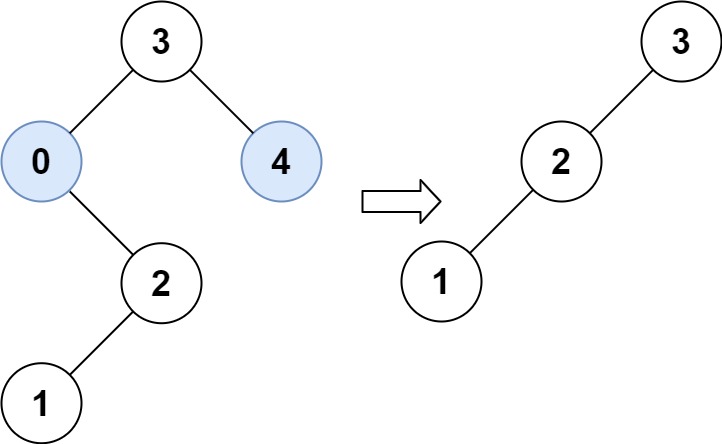上次编辑到这里,代码来自缓存 点击恢复默认模板
/**
* Definition for a binary tree node.
* struct TreeNode {
* int val;
* TreeNode *left;
* TreeNode *right;
* TreeNode() : val(0), left(nullptr), right(nullptr) {}
* TreeNode(int x) : val(x), left(nullptr), right(nullptr) {}
* TreeNode(int x, TreeNode *left, TreeNode *right) : val(x), left(left), right(right) {}
* };
*/
class Solution {
public:
TreeNode* trimBST(TreeNode* root, int low, int high) {
}
};
python3 解法, 执行用时: 52 ms, 内存消耗: 19.2 MB, 提交时间: 2022-11-27 12:20:49
# Definition for a binary tree node.
# class TreeNode:
# def __init__(self, val=0, left=None, right=None):
# self.val = val
# self.left = left
# self.right = right
class Solution:
def trimBST(self, root: Optional[TreeNode], low: int, high: int) -> Optional[TreeNode]:
while root and (root.val < low or root.val > high):
root = root.right if root.val < low else root.left
if root is None:
return None
node = root
while node.left:
if node.left.val < low:
node.left = node.left.right
else:
node = node.left
node = root
while node.right:
if node.right.val > high:
node.right = node.right.left
else:
node = node.right
return root
javascript 解法, 执行用时: 64 ms, 内存消耗: 47.2 MB, 提交时间: 2022-11-27 12:20:32
/**
* Definition for a binary tree node.
* function TreeNode(val, left, right) {
* this.val = (val===undefined ? 0 : val)
* this.left = (left===undefined ? null : left)
* this.right = (right===undefined ? null : right)
* }
*/
/**
* @param {TreeNode} root
* @param {number} low
* @param {number} high
* @return {TreeNode}
*/
var trimBST = function(root, low, high) {
while (root && (root.val < low || root.val > high)) {
if (root.val < low) {
root = root.right;
} else {
root = root.left;
}
}
if (!root) {
return null;
}
for (let node = root; node.left; ) {
if (node.left.val < low) {
node.left = node.left.right;
} else {
node = node.left;
}
}
for (let node = root; node.right; ) {
if (node.right.val > high) {
node.right = node.right.left;
} else {
node = node.right;
}
}
return root;
};
golang 解法, 执行用时: 8 ms, 内存消耗: 6.2 MB, 提交时间: 2022-11-27 12:20:17
/**
* Definition for a binary tree node.
* type TreeNode struct {
* Val int
* Left *TreeNode
* Right *TreeNode
* }
*/
func trimBST(root *TreeNode, low, high int) *TreeNode {
for root != nil && (root.Val < low || root.Val > high) {
if root.Val < low {
root = root.Right
} else {
root = root.Left
}
}
if root == nil {
return nil
}
for node := root; node.Left != nil; {
if node.Left.Val < low {
node.Left = node.Left.Right
} else {
node = node.Left
}
}
for node := root; node.Right != nil; {
if node.Right.Val > high {
node.Right = node.Right.Left
} else {
node = node.Right
}
}
return root
}
golang 解法, 执行用时: 4 ms, 内存消耗: 6.2 MB, 提交时间: 2022-11-27 12:20:01
/**
* Definition for a binary tree node.
* type TreeNode struct {
* Val int
* Left *TreeNode
* Right *TreeNode
* }
*/
func trimBST(root *TreeNode, low, high int) *TreeNode {
if root == nil {
return nil
}
if root.Val < low {
return trimBST(root.Right, low, high)
}
if root.Val > high {
return trimBST(root.Left, low, high)
}
root.Left = trimBST(root.Left, low, high)
root.Right = trimBST(root.Right, low, high)
return root
}
javascript 解法, 执行用时: 72 ms, 内存消耗: 47.1 MB, 提交时间: 2022-11-27 12:19:46
/**
* Definition for a binary tree node.
* function TreeNode(val, left, right) {
* this.val = (val===undefined ? 0 : val)
* this.left = (left===undefined ? null : left)
* this.right = (right===undefined ? null : right)
* }
*/
/**
* @param {TreeNode} root
* @param {number} low
* @param {number} high
* @return {TreeNode}
*/
var trimBST = function(root, low, high) {
if (!root) {
return null;
}
if (root.val < low) {
return trimBST(root.right, low, high);
} else if (root.val > high) {
return trimBST(root.left, low, high);
} else {
root.left = trimBST(root.left, low, high);
root.right = trimBST(root.right, low, high);
return root;
}
};
python3 解法, 执行用时: 44 ms, 内存消耗: 19.4 MB, 提交时间: 2022-11-27 12:19:32
# Definition for a binary tree node.
# class TreeNode:
# def __init__(self, val=0, left=None, right=None):
# self.val = val
# self.left = left
# self.right = right
class Solution:
def trimBST(self, root: Optional[TreeNode], low: int, high: int) -> Optional[TreeNode]:
if root is None:
return None
if root.val < low:
return self.trimBST(root.right, low, high)
if root.val > high:
return self.trimBST(root.left, low, high)
root.left = self.trimBST(root.left, low, high)
root.right = self.trimBST(root.right, low, high)
return root

